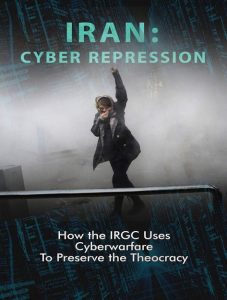
Iran: Cyber Repression, a book published by the National Council of Resistance of Iran, is an ideal revelation of state-backed cyber warfare focused on Iran’s residents and the rest of the world. NCRI sources somewhere in Iran uncover the methods and strategies with which the Islamic Revolutionary Guard Corps (IRGC) and the Ministry of Intelligence and Security (MOIS) participate in the constant surveillance of dissidents using a web of front companies for manufacturing mobile applications equipped with spyware.
Very upsetting, the IRGC effectively sent these spyware applications beyond Iran, making them accessible on global mobile application stores, presumably uncovering the details of a large number of customers around the world, including the United States. The book contains details of how cyber warfare has been used as a tool within Iran. The Telegram news app is effectively used by 40 million Iranians and played an essential role in disseminating data during the protest against the Iranian regime.
Nonetheless, as the book reveals, the Iranian Revolutionary National Guard released elective news apps introduced with malware into the app marketplace. The National Guard, at this point, is using these apps to track and combat the spread of provocative data. The system’s limited effort on the digital front highlights the demand for a free website in Iran and its central role in propagating an effective enemy of religious dissent. The details contained in this book provide a better understanding of how to best fight against the Iranian system’s mission of deception and win the current Iranian cyber warfare.
Cyberterrorism became a severe national security issue. Iran’s Islamic Revolutionary Guard Corps (IRGC) created spyware-enabled applications for digital observation and coercion and harnessed innovative western digital technology that targets its residents. Using a similar innovation, Iran could subtly monitor a large number of people or organizations worldwide. Iran, through its highly modernized and innovative cyber-warfare, disrupts and stands as a threat to its very own people and other countries.
The book comprises six core chapters, and the first five focus on the IRGC’S Cyber Warfare. The uprising in Iran against the ruling theocracy erupted in 2017, where the protests sent shockwaves inside the regime and outside the world. The use of technology, cell phones, and social messaging platforms have played a vital role. The internal network of the prominent opposition People’s Mojahedin Organization of Iran (MEK/ PMOI), which is the principal member of the National Council of Resistance of Iran (NCRI), has established that the regime has focused on mass surveillance through malicious code embedded in the IRGC mobile apps to monitor and disrupt the communications of protestors and dissidents actively. Another influx of national cyber warfare, led by the Islamic Revolutionary Corps in teaming with the Ministry of Intelligence and Security, erupted mainly after the protest in Iran.
In recent years, Tehran has used unknown aid to propel its cyber warfare. On September 4, 2012, the Fars State News Agency detailed the acceptance of an agreement between Iran and North Korea to resist digital attacks that raised concerns in the West. Tehran has also benefited from massive aid from Lebanon. Using its impact on Hezbollah, the Iranian system gained access to Lebanese security arrangements for its cyber warfare against the Iranian public while also meeting its objectives of countering the West. In recent years, the Iranian government has moved beyond obstructing and filtering innovation and technology for content control, scrutiny of packages, modification of information, and user behavioural analytics to extend its cyber crackdown at home.
Cafe Bazar is the Android mobile application mall of the Iranian system, which was established in February 2010. The founding individuals of this organization are individuals of the Basiji paramilitary students connected to the IRGC intelligence organization and the IRGC intelligence base in Ammar Organization. Cafe Bazar application installed malicious code and spyware capable of reading sent messages and controlling Wi-Fi. Since December 2017, the Iranian system has started a severe mission pushing a few local messaging administrations as options, unlike Telegram. There are nearly 100 apps with malware and spyware inserted locally and are informal Telegram forms. These messaging apps are located on the local Cafe Bazar app store and controlled by cyberwar artists connected to the IRGC.
The book also gives insight into the key players in Iran’s latest Cyberwarfare. The IRGC primarily leads the regime’s cyber warfare. The Ministry of Intelligence (MOIS) and the State Security Forces (NAJA) also have cyber warfare sections. The IRGC’s central headquarters for cyber warfare is known as the Ammar Cyberspace Base. IRGC’s cyber warfare organization is under the command of the IRGC’s Intelligence Organization, which is headed by the cleric Hossein Taeb and his deputy, Brigadier- general Hossein Nejat.
The last chapter of the book focuses on the Policy recommendations countermeasures to cyber repression in Iran. The inaction of the international community and its ambivalence gives confidence to the Iranian government to continue with the cyber repression. The NCRI suggests that, in order to counter Tehran’s increasing threat, a comprehensive and decisive policy must be adopted, including sanctions against the IRGC and its front companies. The sanctions should also be imposed on individuals who are involved in cyber warfare.
In recent years, the ability to use and understand current technology has overtaken our creative minds, but our ability to protect has lagged. Iran: Cyber Repression is essential to see how the gap could be misused for our inconvenience.













